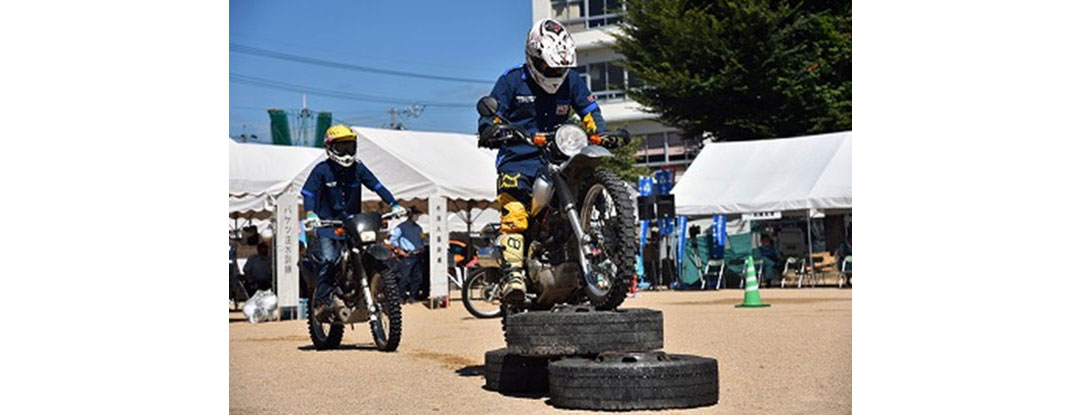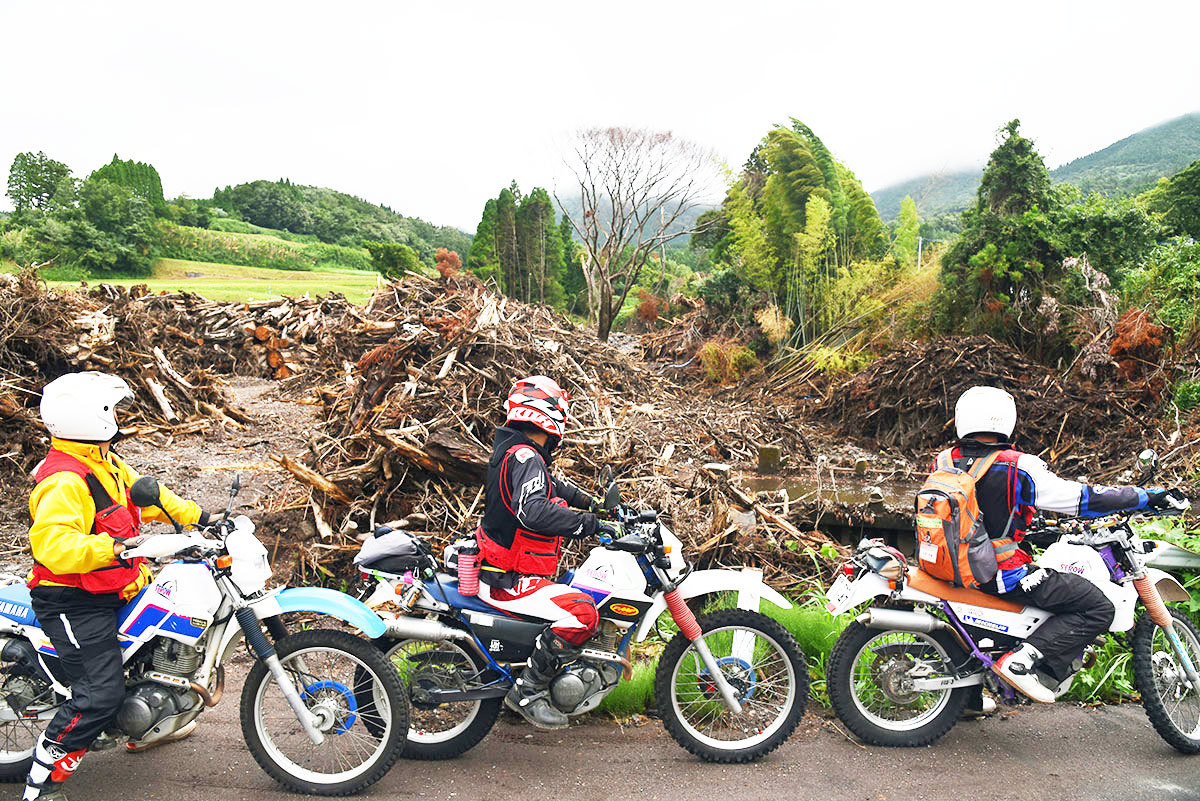Yufu City, Oita Prefecture and Takayama City, Gifu Prefecture were severely affected by the heavy rain during July 2020. The Yufu Motorcycle scout team and Hida Takayama Motorcycle scout team, private volunteer organizations, dispatched members to local disaster sites and engaged in collecting information such as on the state of damage to roads. The Yufu Motorcycle scout team also helped in investigating the safety of elderly individuals in stranded villages. The Hida Takayama Motorcycle scout team transported firefighters (drone team) to areas that were difficult to reach and also aided in collecting valuable information.
Motorcycles have appeared to be useful at the sites of disasters caused by large-scale earthquakes as they can be used to travel across debris and aid in more rapid information collection. In recent years, major windstorm and flood damage has been sustained in Japan. Are motorcycles useful at disaster sites overflowing with water and/or mud? We investigated how motorcycles were utilized at towns affected by the heavy rains of July 2020.
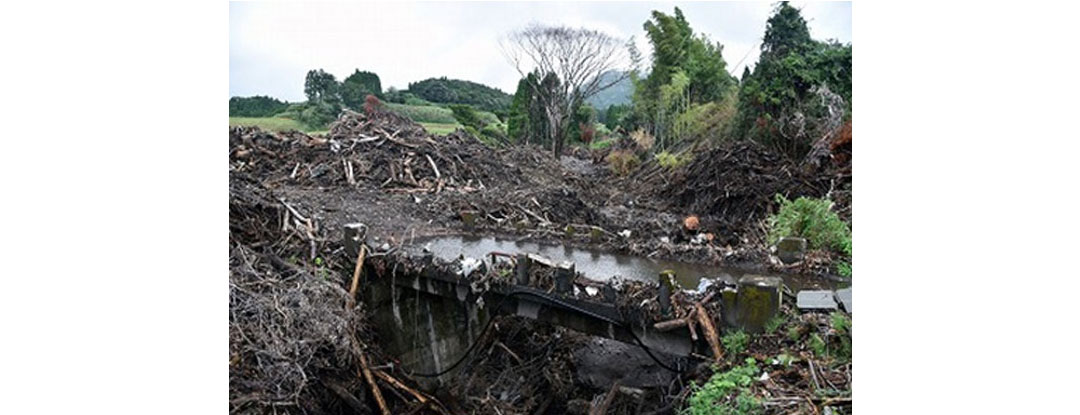
The Heavy Rain Event of July 2020 that Caused Terrible Damage
During the Heavy Rain Event of July 2020, record heavy rainfall between July 3 – 31 caused damage throughout Japan. Torrential rainfall occurred in the Kyushu region from July 3 – 8 and in the Gifu Prefecture region from July 7 – 8. Later, extremely heavy rain fell continuously in the Chugoku and Tohoku regions.
Heavy rain causes rivers to overflow, and debris avalanches to destroy roads and houses. The Heavy Rain Event of July 2020 flooded over 18,000 houses throughout Japan. It also resulted in 83 deaths and 3 missing people for reasons such as being washed away in the flood waters.
During this disaster, while firefighters, police officers and Self-Defense Force members, etc. engaged in lifesaving and rescue activities, some private volunteer organizations engaged in information collection and rescue operations using motorcycles. These were the Yufu Disaster Volunteer Motorcycle scout team (Yufu Motorcycle scout team) in Oita Prefecture and the Hida Takayama Motorcycle Disaster Rescue Group (Hida Takayama Motorcycle scout team) in Gifu Prefecture. These groups dispatched members to local disaster sites to contribute in ways that only motorcycles can do. We will report on two such activities here.
Heavy Rains Hit Yufu, Oita Prefecture – Late at Night on July 7
A recommendation to evacuate was announced over the entire city on the morning of July 7 in Yufu, Oita Prefecture. The rain showers grew stronger from late at night and by midnight, torrential rainfall of 90 mm per hour was recorded. A member of the Yufu Motorcycle scout team who lives near the Oita River said, “I could hear a muffled booming sound together with the sound of rain. It was the sound of big rocks rolling around in the river’s rapid torrent. I was really scared.” Tomitaka Ono (70), leader of the Yufu Motorcycle scout team, reflected, “I had never experienced such a downpour in my 70 years of life. I don’t think anyone was able to sleep that night. I mentally prepared myself because I was sure that it would cause a lot of damage.”
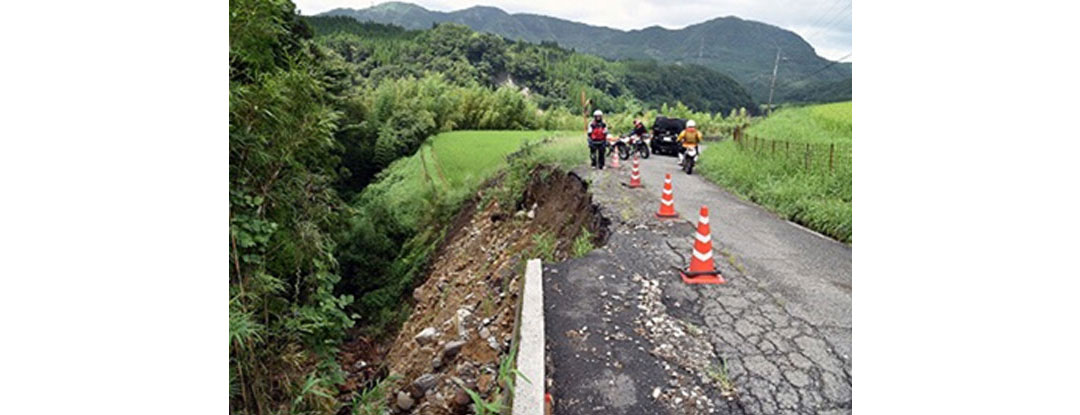
According to the Yufu Safety and Disaster Prevention Section, the Oita River and its tributaries, which flow throughout the town, overflowed due to the rain that night and three regions including Yufuin flooded. The Kurokawabashi Bridge and Shinryubashi Bridge were destroyed. Debris avalanches and landslides made various major roads closed, with water supplies cut off in many areas. Keiji Shuto, head of the Safety and Disaster Prevention Section, said, “Although we earnestly made every effort to respond, raising the warning level to the highest point, unfortunately enormous damage could not be avoided. As there are areas and situations that firefighters/police officers cannot reach when large-scale disasters occur, we are very grateful for the cooperation of private volunteers.”
Tadahide Kurishima, secretary-general of the Yufu-City Social Welfare Council, said, “I was informed by a resident of the Asono district (southwest Yufu), which is located in a mountainous area, that the prefectural road appeared to be impassable. As there were some elderly residents of that area who received meal delivery services, I needed to get more detailed information. So, I told the Motorcycle scout team that the Asono district might be stranded.”
Traversing Roads Cutoff by Debris Avalanches to Reach Stranded Villages
Motorcycle scout team Leader Ono said, “Although the council didn’t give us an official request, we understood what was needed. We decided to voluntarily take action to investigate the damage of the prefectural road leading to the Asono district and to report on this to the council. I also took two team members with me and we set off on three off-road motorcycles in the afternoon of July 8, after the rain had stopped.”
As we rode up the mountain roads into the Asono district, there were rocks and fallen trees along the road and it appeared impassable for automobiles. At some sites, major portions of the shoulders of the road had collapsed. The team took photographs of such sites of damage and recorded where the sites were located on a map on their smartphones. This information was then shared with the council and Safety and Disaster Prevention Section so that it could contribute to securing traversable routes and repairing roads.

Motorcycle scout team Leader Ono said, “The prefectural road was in a terrible state. Although some parts of it were covered in mud and there were also fallen trees, we were actually able to travel over these areas with off-road motorcycles. However, there was also an area where the mud and fallen trees had been piled up so high that we couldn’t cross the area even with a motorcycle. As the village was located further past this point, we travelled off-road, searching for ways that we could get through the mountain in order to reach our destination.” This road “through the mountain” refers to thickets and copses of trees with no roads. Apparently, Motorcycle scout team members regularly practice entering and riding through such areas.

The activities of the Motorcycle scout team revealed that an alternative route could be used to transport supplies to the Asono district. However, there were two completely stranded houses. As the Motorcycle scout team was concerned about the safety of these residents, members called upon each house. While nobody was at home at one house, they found a woman who was close to 90 years old was left alone in the other house.
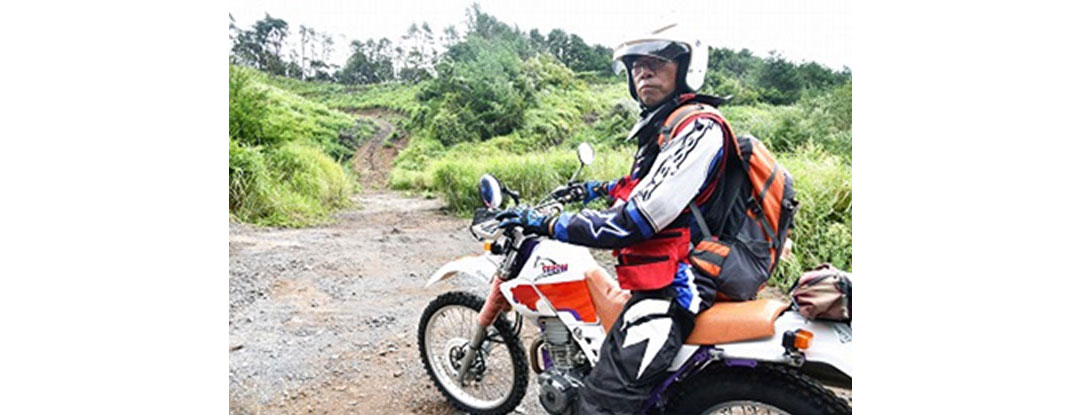
Motorcycle scout team Leader Ono said, “When we reached her, she was truly relieved, saying ‘Good to have you here!’. As she had enough water and food, we gave her an explanation of the surrounding situation and asked her to keep waiting at home.”
Although this was not one of the group’s initial aims, they also conveyed such information on residents’ safety to the government. Those were great results that could be -achieved by the mobile power of the Motorcycle scout team.
Aiming for a Network to Cover the Entire Prefecture
The Yufu Motorcycle scout team was established in December 2014 as the first disaster rescue Motorcycle scout team of Oita Prefecture , comprised of private volunteers. Currently, 22 members are active mainly in the middle region of the prefecture.
Seiji Ono (58), is a founding member and currently in charge of PR for the Motorcycle scout team, said, “Many of the members actually working during disasters, including our leader, are experienced in trial competition and are therefore very skilled motorcycle riders. We engage in regular riding training each month. We make an original hazard map so that we can identify rough forest roads that might not be on existing maps.” It appears that regular training such as this resulted in members of the Yufu Motorcycle scout team greatly contributing to disaster response efforts.
Another major feature of the Yufu Motorcycle scout team is the fact that most of its members are qualified “disaster prevention experts.” This deepens the level of cooperation with the municipal Safety and Disaster Prevention Section and the Council of Social Welfare, while also creating a cooperative relationship with the government as joint disaster management drills are conducted with the local fire department and the police.
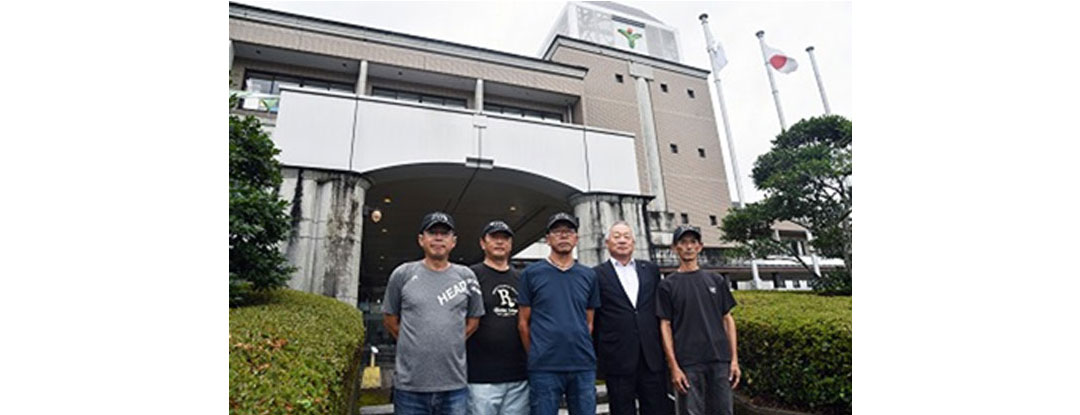
Mr. Ono stated, “What private volunteers need to do is to gain the government’s trust. It is important that people become familiar with each other through joint training and the like. Otherwise, they won’t be able to rely on each other during emergencies. As we are only a volunteer organization, the weight of responsibility constantly lies with us so we thoroughly implement crisis management.”
In September 2017, the Yufu Motorcycle scout team established an Oita Prefecture Disaster Volunteer Motorcycle scout team Office. An “Agreement on Emergency/Rescue Transport” has been concluded with the Oita prefectural government, specifying that the group will mobilize members if a request is received from the prefectural government during a disaster. Therefore, encouragement by the Yufu Motorcycle scout team later resulted in the establishment of the “Houhi Disaster Volunteer Motorcycle scout team” in November 2019 and the “Northern Region Rescue Support Motorcycle scout team” in February 2020. Thus, advances have been made in developing a network to cover the Oita Prefecture in its entirety.
Mr. Ono explained, “In preparation for a major disaster such as a Nankai Trough Mega Earthquake, we, as riders, want to continue to engage in activities that are useful for society such as utilizing the mobile power of motorcycles to collect information and transport emergency supplies.”
Motorcycle scout team Also Active During Disaster in Takayama, Gifu Prefecture
The Hida Takayama Motorcycle scout team is a volunteer disaster rescue Motorcycle scout team that engages in activities mainly in Takayama, Gifu Prefecture. It was formed in October 2007 by five enthusiastic rider of enduros which are off-road endurance races for motorcycles.

Currently, the number of members has increased to 60 people, with a wide range of ages, from teens to their 60s. Some members are also from other prefectures. The organization is registered as a “Takayama Resident Activity Group” and is highly trusted by the government as it also proactively participates in regional disaster management training.
As stated above, the Heavy Rain Event of July 2020 also caused significant damage in Gifu Prefecture. In Takayama, very heavy rain continued from July 7 till <s>–</s> 8, and an evacuation order was issued to all regions in the city (approximately 36,000 households) on the morning of July 8. Fortunately, there was no casualty. However, there were 6 landslides, 44 sites of road damage, and 34 houses were flooded (as of July 10). Moreover, as of midday July 8, a total of 659 households were stranded within multiple districts due to roads being impassable.
Akira Ogiso (61), leader of the Motorcycle scout team, received a telephone call from the Takayama Crisis Management Section in the afternoon of July 8. He received a request to investigate the status of roads in stranded districts.” Utilizing the Motorcycle scout team’s LINE account, Mr. Ogiso entrusted the mission to who would be available on the following day.
Overcoming Successive Obstructions
The five Motorcycle scout team members attended a meeting with the Crisis Management Section on the morning of July 9. The group decided to use five off-road motorcycles to investigate a route of approximately 13 km extending from Akigami-dam in Asahi-machi to a holiday villa area in Suzuran-kogen (Nishibora, Asahi-machi).
Daisuke Matsubara (35), one of the members, attached an action camera to his helmet and shoot a video of the trip to the destination. Mr. Matsubara said, “I was able to record footage showing how roads had been damaged by the heavy rain and how motorcycles were able to overcome all of the many obstructions that we encountered along these roads.”
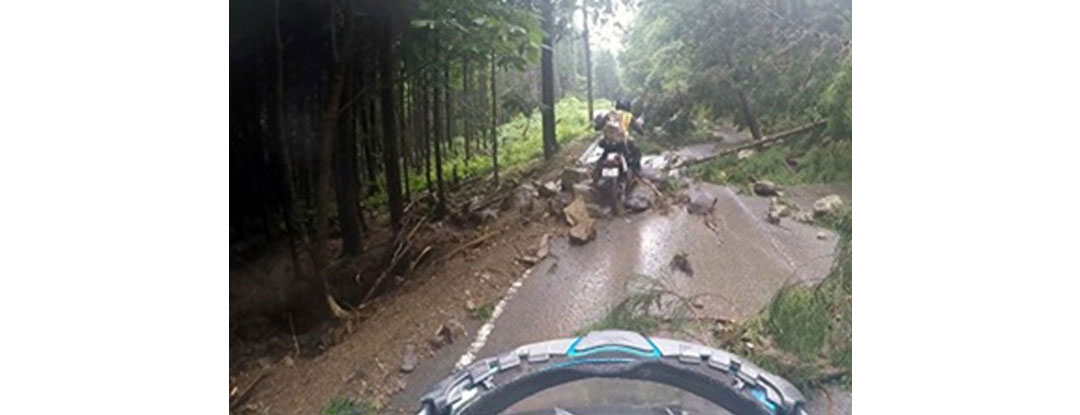
Looking at the footage, one can see rocks spread on and around the mountain roads. Although this would prevent the passage of an automobile, it is hardly problematic for a motorcycle. However, there were some heavily damaged sites where the road had collapsed except only a very small passable area, or where water had flowed in, making the road surface like a river, and other areas that had been completely covered with debris from an avalanche. There were also many collapsed trees, blocking the road at some sites.

When they encountered such obstructions, they would dismount from their motorcycles and work together to lift up or pull their motorcycles over the obstructions. Alternatively, they would use a saw to cut down fallen trees so that they could pass through. The Motorcycle scout team successfully reached Suzuran-kogen around lunchtime and then sent the footage that they had taken of the damaged roads to the municipal Crisis Management Section. They encountered some campers at the site. After confirming that they had enough water and food, they gave the campers an explanation of the state of the road and then made the return trip.
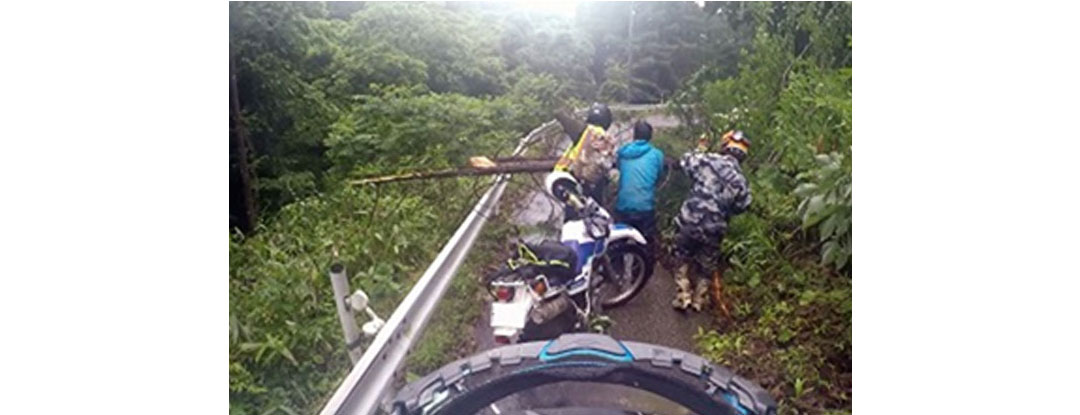
Mr. Matsubara said, “Although the main roads leading to Suzuran-kogen were significantly damaged, we were able to find an alternative route on the return trip. Although this alternative route is a narrow road, it had sustained relatively little damage. If this road could be restored first, it could re-establish access to Suzuran-kogen. The fact that we were able to obtain this information was a major result of our activities.”
Collaboration Between Fire-Defense Headquarters Drone Team and Motorcycle scout team
Upon returning from their field survey, the Motorcycle scout team was assigned the following mission. They were asked to return to Suzuran-kogen, taking three Drone Survey Team members of the Takayama Fire-Defense Headquarters by motorcycles. The firefighters were put on the back of three motorcycles and another motorcycle accompanied those, transporting supplies. With a total of four motorcycles, they made the trip to Suzuran-kogen.
As they went by the alternative route that they had previously confirmed, they were able to reach their destination without any major problems. One of the firefighters who traveled with the Motorcycle scout team members said, “Drones are effective for video-shooting areas affected by disasters and they can be remotely operated from a distance of up to approximately 2 km. However, due to topographical features and the like, it is not actually possible to operate them at such distances. By going as far as we could on motorcycles and then flying the drone as we did this time, we were able to obtain more useful information.”
Shinji Hashido (42), a member of the Motorcycle scout team, commented, “Over my seven years as a member of this group, this is the first time that I have been mobilized for a disaster. Being able to help transport firefighters was a very valuable experience for me. As my hobby is enduros, I wasn’t at all hesitant to ride through even muddy areas. We were able to engage in all of these activities, ensuring safety. A major success of these activities was the fact that we were able to prove the mobile power of motorcycles during heavy rain events. I hope to apply what I learnt here in future activities.”
The Hida Takayama Motorcycle scout team holds “Takayama Resident Scooter 4-hour Endurance Sports Meets” several times per year using a dirt course within the city as a charity activity for areas affected by the Great East Japan Earthquake. The events are very lively, with participation by locals, including young people.
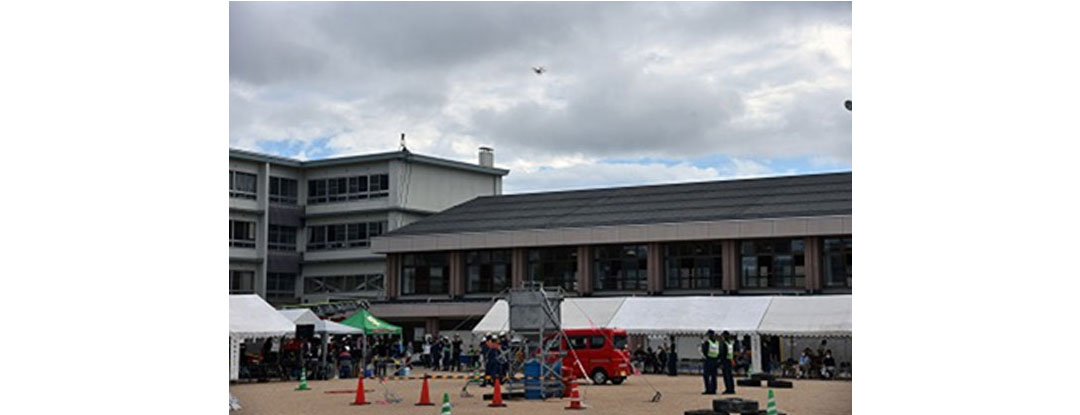
Motorcycle scout team Leader Ogiso said, “It makes me happiest that young people who enjoy our scooter sports meets say that they want to join our Motorcycle scout team. This has resulted in our members gradually increasing. As the aging of the population progresses, we are facing the issue of creating successors for our Motorcycle scout team. We want to pass on to the younger generation a sense that motorcycles are truly an enjoyable form of transportation and members of the community need to work together to protect each other.”
